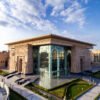Located on the Giza Plateau near Cairo, Egypt, the Pyramids of Giza stand as an astonishing tribute to ancient Egyptian innovation and cultural legacy. This impressive site includes three main pyramids, the famous Sphinx, and several smaller monuments. For thousands of years, these structures have inspired wonder and admiration among historians, archaeologists, and travelers alike.
Exploring the Pyramids of Giza: Wonders of Ancient Egypt

Built during Egypt’s Fourth Dynasty, around 2580 to 2560 BCE, the Pyramids of Giza were monumental tombs for Old Kingdom pharaohs. Initially, the complex included three main pyramids: the Great Pyramid of Giza, the Pyramid of Khafre, and the Pyramid of Menkaure. As part of a necropolis meant to honor Egypt’s divine rulers, these pyramids ensured their journey to the afterlife and preserved their legacies.
Over time, the pyramids came to symbolize not only the pharaohs’ divine status but also the skilled artistry and engineering prowess of ancient Egyptians. The site’s grandeur remains a powerful reminder of Egypt’s fascinating history.
The Great Pyramid of Giza: An Architectural Marvel

The Great Pyramid, known as the Pyramid of Khufu or Cheops, stands as the largest of the three pyramids. Originally reaching 146.6 meters (481 feet), it held the title of the world’s tallest artificial structure for over 3,800 years. Built from approximately 2.3 million stone blocks, each weighing between 2.5 and 15 tons, the Great Pyramid reveals the Egyptians’ remarkable understanding of mathematics and astronomy.
The Great Pyramid’s precise alignment with the cardinal compass points and complex internal passages reflect an advanced grasp of architectural techniques. This level of sophistication continues to astonish visitors and experts alike.
The Pyramid of Khafre: Recognizable and Remarkable

The Pyramid of Khafre, built by Pharaoh Khafre, sits on an elevated platform, giving it the appearance of being taller than the Great Pyramid. However, it is slightly smaller. This pyramid is notable for the smooth casing stones that once covered its surface, adding a polished look to its exterior.
Adjacent to this pyramid stands the Great Sphinx, a massive limestone statue with a lion’s body and a pharaoh’s head, widely believed to depict Khafre. This unique combination of pyramid and sphinx showcases Khafre’s legacy and adds to the allure of the Giza complex.
The Pyramid of Menkaure: Small Yet Significant

The Pyramid of Menkaure is the smallest of the three main pyramids. However, it stands impressively at 65 meters (213 feet). Pharaoh Menkaure chose limestone and granite for its construction. This choice sets it apart since granite was rarely used. Additionally, Menkaure commissioned three smaller pyramids for his queens. This addition enhances the grandeur of his legacy.
Despite its size, the Pyramid of Menkaure reflects the high level of architectural detail characteristic of Egypt’s Fourth Dynasty. The intricate work within its mortuary temple further emphasizes Menkaure’s contributions to ancient Egyptian culture.
The Great Sphinx: Guardian of the Pyramids

Protecting the pyramids is the Great Sphinx of Giza, an iconic symbol of ancient Egypt. Carved from a single limestone piece, the Sphinx stands about 20 meters (66 feet) tall. It stretches 73 meters (240 feet) in length. Its face resembles Pharaoh Khafre, adding a mysterious quality as the guardian of the Giza Plateau.
Its exact purpose remains uncertain. However, the Sphinx intrigues researchers and visitors alike. It embodies the enduring enigma of ancient Egypt.
Theories on Pyramid Construction
The methods used to build the pyramids still captivate researchers today. Theories vary widely, from the use of ramps and levers to more speculative ideas involving advanced technology or even extraterrestrial help. However, most evidence points to a system of ramps and skilled laborers—not slaves—as essential to the process.
The pyramids’ precision and craftsmanship highlight the engineering skills of ancient Egyptians and their ability to organize massive projects. These achievements remain benchmarks of human ingenuity and ancient technology.
Preserving the Legacy of the Pyramids of Giza
The Pyramids of Giza have endured natural erosion, human interference, and the passage of time. Consequently, they gained UNESCO World Heritage Site status in 1979. This designation highlights their universal cultural value. Today, ongoing preservation efforts help maintain these wonders. As a result, future generations can experience and admire them.
The Pyramids of Giza not only represent ancient Egypt’s architectural mastery but also symbolize a profound legacy that spans millennia. They embody the Egyptian quest for immortality and offer insight into the civilization’s understanding of the cosmos.
For travelers eager to connect with ancient Egypt, visiting the Pyramids of Giza offers a timeless experience like no other. Odysseys Voyage provides exclusive travel packages featuring guided tours of the Giza Plateau, allowing you to walk in the footsteps of pharaohs and uncover the mysteries of these iconic structures.
Follow us on Instagram for updates, tips, and glimpses of Egypt’s most breathtaking sites. Embark on your journey with us, and let the Pyramids of Giza reveal the wonders of Egypt’s ancient legacy.




